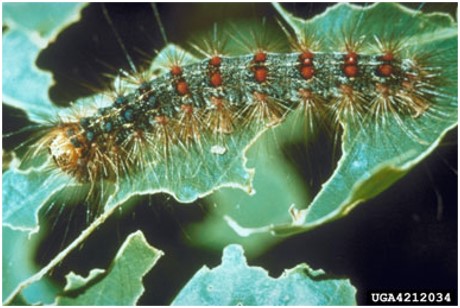Spongy Moth (formerly Gypsy Moth)

Photo: Petr Kapitola
Hot Topic: Spongy Moth
his moth, Lymantria dispar, was accidentally introduced in Massachusetts in 1869. The first outbreak occurred in 1889 and the spongy moth is now established throughout the northeastern United States. Spongy moths are able to move long distances on outdoor household articles such as cars and recreational vehicles, firewood, and household goods. Females often lay egg masses on such articles which are then accidentally transported by people, spreading the pest.
These insects are so destructive because the caterpillars can fed on more than 500 trees and shrubs. Oaks are a preferred host while apple, sweetgum, basswood, gray and white birch, poplar, willow, and hawthorn are also favored. Older instars can feed on hemlock, pines, and spruce. Caterpillars are recognizable since they have five pairs of blue dots and six pairs of red dots on their back and are very hairy. Adult female moths are large, white, and flightless while males are smaller, brown in color, and can fly.

Photo: Peter A Rush
Spongy moths are not established in Kentucky, but are established in the surrounding states of Virginia, West Virginia, Ohio, and Indiana. From 2000-2002, West Virginia experienced record defoliations that totaled over 1 million acres. During an outbreak, even in the summertime trees appear as though it's wintertime since caterpillars eat all of the leaves on the trees and leave them bare (see picture below).

Photo: Haruta Ovidiu
Is it Close to Kentucky?
Some spongy moths are found every year in Kentucky. However, there are no established breeding populations in the state and we are working to make sure this insect does not become established. A map of counties in other states which are under quarantine due to spongy moth can be found below.
Below is a graph of the number of moths captured each year in Kentucky since 1983 when the detection program began.
What's Being Done?
Every year, thousands of spongy moth traps (pictured below, but may be green, brown, or orange) are set throughout the state of Kentucky. These traps contain a synthetic female spongy moth sex pheromone which will attract the male moths. We participate in a statewide detection survey as well as the Slow the Spread program which focuses on slowing the naturally-advancing spongy moth front in the eastern part of the state. Kentucky has trapped for spongy moths since 1983.

Photo: Chris Evans
Since the start of the spongy moth detection program, three infestations have been discovered and eradicated using techniques such as 1) mass trapping in which a very large number of traps is concentrated in the infested area, 2) application of nucleopolyhedrosis virus (Gypchek®) which kills only spongy moths (see picture below), and 3) banding trees with burlap bands treated with insecticide to kill caterpillars. Thus far our extensive monitoring program and eradication techniques have prevented this damaging pest from becoming established in Kentucky.

Photo: John Ghent
